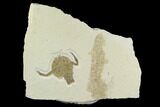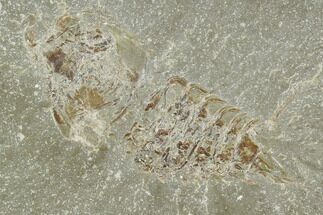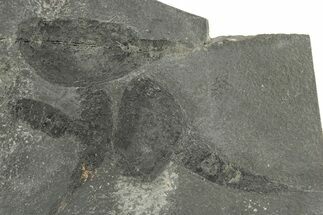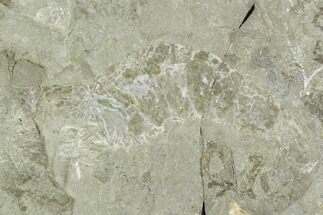This Specimen has been sold.
4" Eryon Crustacean - Solnhofen Limestone
This is a very large, 4" long specimen of Eryon arctiformis an extinct type of decapod crustacean from the Solnhofen Limestone of Germany. Eryon was thought to have fed on particulate matter on the sea floor, probably having a similar lifestyle to a lobster.
It's beautifully presented on a large slab of limestone with its claws outstretched. There is a large section of fossilized coral naturally associated with it. There is some restoration on the left hand edge just above the tail and a few other touchups to the tail.
It's beautifully presented on a large slab of limestone with its claws outstretched. There is a large section of fossilized coral naturally associated with it. There is some restoration on the left hand edge just above the tail and a few other touchups to the tail.
The Solnhofen limestone is a famous Upper Jurassic lagerstätte in Germany. It is where one of the most famous fossils of all time, Archaeopteryx, was found. The fine-grained limestone makes excellent building material, which has led to heavy quarrying over the past two centuries. In the process, some spectacular fossils were unearthed, including fossil dragonflies, fish, pterosaurs, shrimp, horseshoe crabs, and many more.
This area represents an ancient archipelago at the edge of a sea. Due to high salt content, the lowest levels in the water column could not support much life and were largely devoid of oxygen. This lack of oxygen and scavengers on the bottom of the sea led to beautiful fossil preservation.
This area represents an ancient archipelago at the edge of a sea. Due to high salt content, the lowest levels in the water column could not support much life and were largely devoid of oxygen. This lack of oxygen and scavengers on the bottom of the sea led to beautiful fossil preservation.
SPECIES
Eryon arctiformis
LOCATION
Eichstatt, Germany
FORMATION
Solnhofen Limestone
SIZE
4" long, Limestone 14x12.5"
CATEGORY
ITEM
#130604
We guarantee the authenticity of all of our specimens.
 Reviews
Reviews












